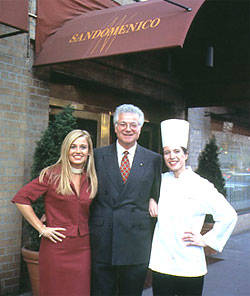Authentic Italian Cuisine in the US? Mr. May’s Possible Mission
Interview with Tony May, the owner of some of the most exclusive Italian restaurants and eateries in New York City. His legendary San Domenico Restaurant at Central Park closed just one year ago to be replaced by the bigger and more youthful SD26.
He is the founder and president of GRI-Gruppo Ristoratori Italiani (Group of Italian Restaurateurs), whose aim is to elevate the standards and understating of authentic Italian cuisine in this country. GRI is based in New York and implements Italian culinary programs throughout the United States, by which American and Italian-American students and cooks learn about the main ingredients and recipes of Italian culinary tradition.
We met him at the Wedding Café (16 East 38th Street), one of his restaurants.
First of all, I would like you to tell me about your first experiences in this country. You came here 40 years ago and Italians here suffered great discrimination…
When I came here in the USA in 1963 Italian culture was not strong at all. People spoke a language I did not understand and ate food I never had before. It was very different from today. Today we are enjoying a much better understanding of Italian cuisine by Americans thanks to the efforts of many experts in the field who came to America in the last 40 years: while the early Italian immigrants were very poor, and sometimes illiterate and uneducated, today more and more graduate and middle and high-class people are coming here. The cultural input now is entirely different, so things are getting better.
However, after a tough beginning I had a fast and ascending career. During my first twenty years in America, I worked in international cuisine restaurants. Among them, the Rainbow Room. I started working there a few months after I arrived in America: in 1964 I was the captain; in 1965 the Maitre de Maison; in 1968 the manager; in 1973 I bought it. The truth is that if you knew what you were doing, you could make a career. There were very few Italian restaurateurs in New York, so I found a perfect environment for my business plans. I had a mission: educate American people about authentic Italian cuisine.
How did you fulfill this goal?
In 1979 I founded the GRI-Gruppo Ristoratori Italiani together with the Italian- American Chamber of Commerce. Our mission is to improve the image of Italian cuisine through education. We do this in two different ways: at the institutional level we established scholarships while at the practical level every year we take our colleagues to Italy.
I know that you come from Torre del Greco, a town near Naples, in Campania. That territory has a strong culinary tradition. Is it present at all in the menus of your restaurants?
I propose only Italian cuisine, the national one. Territorial traditions would keep us at the “trattoria” level while we have to “graduate” and let people understand that our food can also be served in elegant surroundings. China plates and silver dinnerware in our restaurants must substitute the rustic tablecloths of the trattorias: while the latter maintain the traditions, the former make them evolve.
How distant is the Italian food served in American restaurants from the authentic tradition?
The early Italian immigrants created a new kind of cuisine, the Italian-American one. This is because they had to work with the ingredients they found here, so they had to substitute and transform some of the recipes according to what they had and didn’t have at their disposal. Although they had good intentions, they bastardized Italian cuisine. If they had had the possibility to import the necessary ingredients and products, they would not have done it. Today, instead, we have the assortment of ingredients we need, thus it is our duty to spread the real Italian culinary culture. The products denote the kind of cooking that we serve: the better they are, the better is the result.
How did the American public react to this wave of authenticity? Did people appreciate it right from the beginning?
It took a while. You cannot change the perception of Italian cuisine all of a sudden! This is why the fulfillment of the GRI’s mission passes through education: I think that it is the only way to win this battle. We must teach the students our traditions, we must educate them about the quality of our products and the culture of the Italian table. Today there is a deep ignorance about Italian ingredients: as an example, there still are people who do not understand the difference between grana padano and parmigiano and can not discern among different kinds of vinegar. We must give them the instruments to do so: this is fundamental if we want people to appreciate real Italian cuisine.
How do you feel the economic crisis is going to affect its popularity?
I do not think this is going to happen. The quality of our products will remain the same, so people will still love eating Italian. Maybe the quantity of imported goods will diminish and the prices on the menus too. But that’s all: I don’t foresee great consequences on the long run. Eating out will always remain an option for American people: it is part of their lifestyle. And we all know that they prefer Italian
Last year you closed the legendary San Domenico Restaurant in Central Park, but shortly you will start a new business, the SD26…
Yes, the new restaurant will open in September. We planned it to respond to the needs of the new generations. Nowadays when people go out they want to eat in a relaxing and informal environment. Even older people want to look young; they wear jeans and sneakers and look for modernity. The new restaurant will answer this growing demand by offering the consumers a “younger” environment.
The idea of the meal itself has changed: now the public prefers to order smaller portions and taste a little bit of everything and give up the big traditional meal composed of different courses.
So it will involve a different approach to Italian cuisine, won’t it?
The quality of our food will not be affected. We will still produce our own pasta, pastries and crèmes. We will just serve them in a different way, that’s all.
We will give our clients the possibility to eat at both the bar and the dining room. Every recipe will evolve around a product, such as capperi from Pantelleria, oregano from Puglia, olive oil from Tuscany, chocolate from Modica, speck from Alto Adige, so as to highlight how important the quality of the products is for the final result.
Isn’t this approach very similar to the slow food idea?
Carlo Petrini came up with a very good idea a number of years ago. The concept was welcomed and I respect it too. It is a tribute to good quality and genuine products. Actually I have been supporting these two elements as fundamental for Italian cuisine for a much longer time. I made them the mission of the GRI, while the slow food idea is really a business, a very remunerative one. My mission has no lucrative purposes, it is just an initiative promoted to benefit my “madre patria”, my homeland.





































i-Italy
Facebook
Google+
This work may not be reproduced, in whole or in part, without prior written permission.
Questo lavoro non può essere riprodotto, in tutto o in parte, senza permesso scritto.